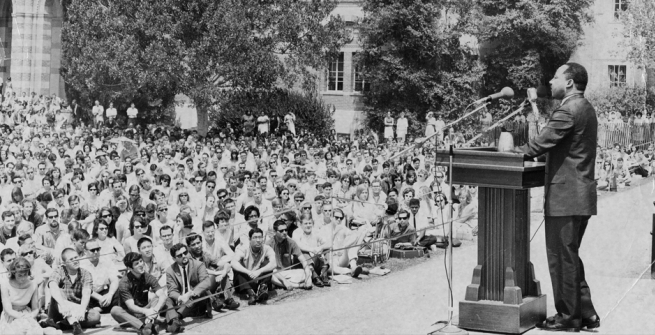Martin Luther King Jr. was born in Atlanta, Georgia, but as in so many cities and towns throughout the country, his impact on Los Angeles was strong and far-reaching. King visited L.A. on numerous occasions to speak about equal rights and encourage voter participation, sometimes under tense, and potentially life-threatening circumstances. When he visited the city, thousands would turn out to hear this great orator and Nobel Peace Prize winner. King was comfortable speaking anywhere and seems to have welcomed every opportunity to get his message out. The venues he appeared in were wildly varied, such as the Los Angeles Sports Arena, the Second Baptist Church, the University of California, Los Angeles (UCLA), and the Hollywood Palladium.
In the wake of King’s assassination on April 4, 1968, the city mourned the fallen leader, and then eulogized him with memorial services held at the Los Angeles Coliseum and the First Methodist Church. In 1983, Los Angeles officially honored the activist by renaming Santa Barbara Avenue as Martin Luther King Jr. Boulevard, three years before his birthday was declared a national holiday. The nearby city of Lynwood followed suit in 1989 by rechristening Century Boulevard with King’s name.
Over half a century following his untimely and violent death, King’s presence in Los Angeles is still apparent. In addition to King Boulevard, where the Kingdom Day parade is held annually, his name is affixed to places around the city like schools, parks, a community college library, and a medical center. Los Angeles may have not been King’s home, but that didn’t stop countless residents of the city from welcoming him and his ideas.
Martin Luther King Jr. at the Los Angeles Coliseum on June 1, 1964. On the speakers' platform are, from left, actor Dick Van Dyke, radio-television personality Walter O'Keefe, the Rev. John H. Burt, and the Rev. Father Joseph Francis, S.V.D. (Photograph by Bob Miller, Valley Times Collection/Los Angeles Public Library)
Martin Luther King and Governor Edmund G. Brown during a Freedom Rally at the Los Angeles Sports Arena on June 18, 1961. An audience of 12,000 was expected at the 18,000 seat venue. When over 25,000 people showed up to hear King speak, many remained outside and listened to the speech over loudspeakers. (Los Angeles Herald Examiner Collection/Los Angeles Public Library)
Martin Luther King Jr. came to Los Angeles in February 1964 and delivered a sermon to a standing room only crowd of 2,000 at the Second Baptist Church. Rev. Thomas Kilgore, pastor of Second Baptist and pictured here, had known King as a youth and recalled, "He was a precocious youngster as I remember, always full of questions and a quick learn." (Rolland Curtis Collection/Los Angeles Public Library)

King is honored by the City of Los Angeles and the World Affairs Council during a luncheon held at the Hollywood Palladium on February 25, 1965. Here he is pictured with (from left), Councilman (and later mayor) Tom Bradley, Supervisor Warren M. Dorn, King, Harold C. McClellan and Mayor Samuel W. Yorty. King arrived in Los Angeles under heavy guard following the assassination of Malcom X, and an anonymous bomb threat was made during the luncheon. When addressing the group, King said, "Before the victory is won, some of us will have to get scarred up a little bit." (Photograph by Dean Gordon, Valley Times Collection/Los Angeles Public Library)
King speaks to a crowd of 4,500 on the campus of the University of California, Los Angeles on April 27, 1965. Here, he called for students to join a "Domestic Freedom Corps" to work in 120 counties of the Deep South to help increase the number of registered African American voters. (Los Angeles Herald Examiner Collection/Los Angeles Public Library)
Los Angeles resident reacts to the news of King's assassination in Memphis, Tennessee. (Los Angeles Herald Examiner Collection/Los Angeles Public Library)
Dr. King's words are emblazoned on an electric board for a memorial at the Los Angeles Coliseum on April 7, 1968. (Los Angeles Herald Examiner Collection/Los Angeles Public Library)
Cesar Chavez, head of the National Farm Workers Union was the opening speaker at the memorial for Rev. Dr. King at the Los Angeles Coliseum on April 7, 1968. Of the fallen activist, Chavez said, "In the labor movement, let us never forget that he died for the right of our workers to organize." (Los Angeles Herald Examiner Collection/Los Angeles Public Library)
A silent procession of 450 clergymen representing all major faiths marched from Pershing Square to the First Methodist Church at the corner of 8th and Hill Streets on April 8, 1968, in honor of Rev. Dr. King. (Los Angeles Herald Examiner Collection/Los Angeles Public Library)
A crowd marches to Los Angeles City Hall in celebration of Martin Luther King Jr.'s birthday on January 15, 1981. (Los Angeles Herald Examiner Collection/Los Angeles Public Library)
Lynwood City Council members stand under the first street sign in memory of Martin Luther King Jr. on April 21, 1989. In 1983 the city of Los Angeles had renamed Santa Barbara in honor of King. (Photo by Steve Grayson, Los Angeles Herald Examiner Collection/Los Angeles Public Library)











